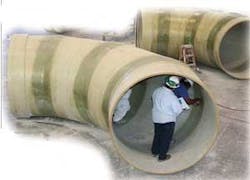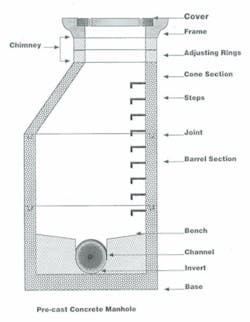Manhole Inspection Key to Collection System Performance
By Denis Pollak
Every day in the United States, millions of people pass over manholes, either on foot or in vehicles, without noticing them. In fact, it wasn’t until about 20 years ago that those in the water/wastewater industry paid much attention either – the old adage of “out of sight, out of mind” seemed to apply. Now the industry is recognizing just how vital manholes truly are to the country’s infrastructure and how their failure could ultimately lead to big problems throughout the U.S.
Studies have shown that much of the groundwater and surface water that enters sewer systems does so through manholes, making them the potential weak link in the system. There are definite consequences if deteriorating manholes are not repaired. From an operations standpoint, infiltration from groundwater impacts the collection system as a whole. From a structural standpoint, if there is a lot of corrosion within the manhole, cave-ins can occur.
Each component of a manhole is at a high risk of failure from normal wear and tear, not to mention factors such as exposure to hydrogen sulfide or poor construction. The manhole invert, which is the bottom of the structure, is the extension of the pipe inlets. They are particularly susceptible to leaks. The bench, the sloped floor between the invert and the wall of the barrel, can deteriorate from abrasion and corrosion. The barrel itself is prone to corrosion, which can lead to structural instability. Manhole rings are susceptible to movement from traffic loads, soil movement and the freeze/thaw cycle.
The good news is, there are resources available to rehabilitate almost any defect that can be found in a manhole. The key is well trained and experienced applicators who understand that manholes are constructed of various materials that have different structural characteristics and require different rehabilitation methods.
Manholes: A History
Before rehabilitation methods can be addressed, it is necessary to take a look back at the history of manholes. Manholes have been in existence in the United States for over 200 years, with some still in service dating back to the pre-Civil War era. At that time, bricks and mortar were the common materials used to construct manholes; however some were built with stone.
When inspecting older brick structures, many have a lot of brick still intact but very little mortar. Depending on the location and condition of the manhole, inspections can uncover a significant amount of root intrusion. In some extreme cases, soil can be seen. In the bottom area of the structure, deterioration of the bench can sometimes be observed. In this case, there may be separations or voids between penetrating pipes into the manhole structure.
Although many of these older manholes are deteriorating, there are some that have stood the test of time. The life span of brick manholes is a testament to the craftsmanship of the builders, especially considering that the bricks were hand-laid. These men were artisans – the pride they took in their work is evidenced by the very fact that many of these manhole structures still exist.
During the mid-20th century there was a shift away from brick and mortar manholes to precast concrete. Areas of spalled concrete and exposed aggregate are typical for manholes built during this time. For the most part, the typical life span of precast concrete manholes is 50 years. This means that now is the time when manholes built in the 1950s and ‘60s are beginning to fail. These manholes need to be inspected and any problems need to be addressed as soon as possible.
In the later 20th century, some manholes were constructed with cast-in place concrete. The condition of this type of manhole typically depends on the quality of the installation process. For example, if reinforcing steel was used, how much concrete cover is over the steel? Those manholes with adequate or more than adequate cover are still in good condition for the most part, and with proper inspection and maintenance can have a life cycle of 40-50 years. Those with inadequate cover are already beginning to deteriorate.
The life cycle of both cast-in place and precast concrete manholes depends primarily on two factors: the severity of H2S exposure and the quality of the construction. H2S eats away at concrete and causes corrosion and, ultimately, the failure of the manhole structure. Poor construction methods can lead to the premature failure of the concrete or lining.
Current Manhole Construction
In the world of manhole construction today, materials such as HDPE, concrete with corrosion reducing additives and plastics are used. Newly constructed concrete manholes are rarely seen without liners. Better specifications are used, and this along with improved construction practices typically means that newly constructed manholes will have a life cycle of 50+ years. However, the lasting power of T-lock and other liners depends on the contractor – a poorly installed T-lock liner can fail within the first 10 years.
Some new manholes have HDPE liners installed versus T-lock. HDPE has its merits; it is a stout material that is manufactured to be thicker than T-lock. Concrete manholes with properly installed HDPE liners can last 40-50 years without deterioration.
There are also some manholes built out of HDPE rings. There are several advantages of this type of construction: 1) It doesn’t require the installation of a liner, 2) It is relatively lightweight, which means that a lot more of it can be loaded onto a truck, translating into money saved and 3) The handling of the material is much easier – heavy equipment is not necessary. It is most likely that HDPE ring manholes can last 75-100 years.
Manhole Inspections
With over 20 million manholes in the nation and many of them in poor condition, what can be done? The first step is to inspect the manholes to determine their condition. The best practice for the manhole inspection is to use a combination of technology and getting down into the trenches. An initial investigation can be conducted with the use of a CCTV camera.
If a particular area appears to be in good shape, further investigation is not required until the next round of maintenance checks. If the area appears to be in poor or questionable condition, then a confined space entry into the manhole is performed. An inspector can pound on concrete and “get a feel” for more than just what the camera shows. However, technology is extremely helpful in this part of an initial manhole inspection. Viewing the manhole via camera limits the number of confined space entries, keeping workers safe and costs down.
Manhole inspectors are like detectives – consistency is necessary in all aspects of investigation in order to make the most of the clues. The inspector needs to look closely at all defects and document his/her visual observations. This is why NASSCO’s Manhole Assessment Certification Program (MACP) is a valuable tool. This program allows for consistency of documentation and a repeatable process for evaluation. In this way, a long-term approach to manhole rehabilitation can be undertaken rather than simply reacting when problems arise.
The goals of MACP coding are to define attributes and features of the structure, document and explain defects, develop ratings for each applicable component of a manhole – structural rating, O&M rating, I/I rating – and record dimensional data that can be used for selecting rehabilitation methods. This standardized method for reporting the results of condition assessments keeps everyone on the same page, promotes cost efficiency and avoids unnecessary rehabilitation work.
Rehabilitation Methods
In most cases, rehabilitation of the manhole is chosen over replacement due to cost and logistics. When determining what rehab methods to use for a particular manhole, it is important to note that a one-size-fits-all approach is not the best idea. No two manholes are identical. Site specific considerations such as physical location, access and right of way can be different for two manholes suffering from the same internal corrosion issues.
Fully understanding the challenges involved will help guide the rehab process. For example, where is the manhole located? Poor access to a manhole can greatly impair the ability to rehab that particular manhole. Are there any traffic control measures that need to be considered? What about flow issues, elevated H2S levels or moisture? Will it be necessary to ventilate and dehumidify? Is there root intrusion and/or infiltration? What are the cost constraints? How long does the rehab need to last? A 50-year fix isn’t necessary if manhole replacement is planned for 10 years down the road. Being armed with the answers to these questions will help ensure that the rehab process goes smoothly.
Depending on the answers to the above questions and the specific defects of the manhole, coatings, liners or a combination of both may be used to fix the damage. When it comes to coatings, spray applied epoxies, urethanes and cementitious coatings that are calcium aluminate based are all used in rehab work. Other options include repairing existing liners with a similar material. Arrowlock® is a PVC-like material that uses mechanical adhesion to repair failing T-Lock® liners. There are also other products, such as Linabond®, that uses a chemical adhesion process to achieve the same type of repair.
At times, a combination of methods may be appropriate. For example, failing T-Lock® may be cut out and the concrete beneath coated. If using a combination method such as this, the two rehab methods need to work well together, with a proper interface occurring between the coated concrete and the remaining liner.
Full replacement or installation of structural liners, such as Poly-Triplex® Liners, comes into play in situations where a coating simply isn’t enough to fix the problem. The old liner is replaced with a new structurally reinforced cure-in-place liner.
Regardless of the rehabilitation method chosen for a particular manhole, the goal is to create a corrosion barrier to prevent manhole deterioration. Although the main consequence of a failing manhole is I/I, in extreme cases dangerous conditions can result from a corroded, deteriorating manhole. WW
About the Author:
Denis Pollak is Condition Assessment Manager for V&A Engineering, an independent consulting engineering firm specializing in corrosion engineering, coatings system management, and condition assessment services. Pollak has more than 35 years experience in project management on water and wastewater projects. He was a founding member of the California Water Environment Association Southern Sections Collection System Committee and is a former President of the CWEA, San Diego Section.





